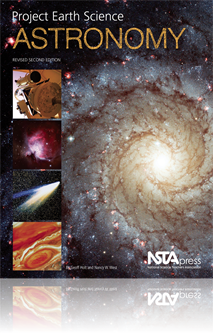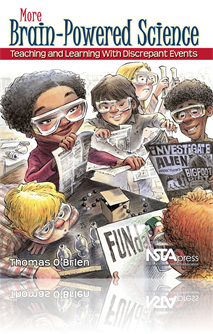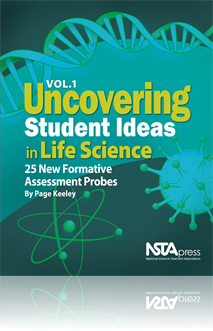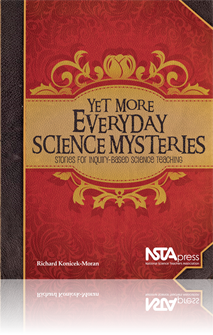All Book Chapters
Book Chapter
The Reading on Rocks and Minerals elaborates on the concepts presented in the Activities section of Project Earth Science: Geology, Revised 2nd Edition. This Reading was written especially for this volume with the teacher in mind. Typical rocks...
Book Chapter
Seafloor Spreading: Divergent Plate Boundaries
Students, in this activity, will make and use a paper model to understand seafloor spreading. By doing so, they explore patterns of rock ages and rock magnetism parallel to mid-ocean ridges. ...
Book Chapter
Careers in Geology and Geosciences
The Reading on Careers in Geology and Geosciences provides a resource for teachers to help students know what geologists do and how to become one. The Readings were written especially for Project Earth Science: Geology, Revised 2nd Edition. with ...
Book Chapter
In this activity, students will experiment with the old but still useful technique of using sounding lines to make seafloor maps. As is done often in science and in other fields, students will work in teams. They should observe that the number of mea...
Book Chapter
Rocks Tell a Story: Rock Characteristics and Environmental Clues
Identifying rocks can be difficult, even for geologists. Proper rock identification depends on the quality of the specimen and on the clarity of its significant characteristics. In this activity, students observe and compare pairs of related rocks an...
Book Chapter
The Rock Cycle: Rock Formation and Change
A single rock could provide an example of how slowly most geological changes occur on Earth. If you picked up a rock and kept it for the rest of your life, you would probably notice that it changes little, if at all. Yet, rocks can and do change; it ...
Book Chapter
Students, in this activity, use a globe and lamp to model Earth’s orbit. From this concrete model, they see and understand that the cause of Earth’s seasons is the tilt of its rotational axis....
Book Chapter
The greenhouse effect refers to the way Earth’s atmospheric gases create a barrier that allows the heat from the Sun to penetrate and be absorbed by Earth’s surface. The heat is trapped, much like in a greenhouse. The greenhouse effect on Venus w...
Book Chapter
Every 29.5 days, the Moon’s shape appears to change in a predictable cycle. We call the shapes phases of the Moon. This activity will show how the Moon’s orbit causes the Moon’s phases. Students use Ping-Pong or Styrofoam balls to model the way...
Book Chapter
Students, in this activity, measure distances by walking heel-to-toe in the unit “student minute.” This is to gain an intuitive under¬standing of light years, a unit in which time represents distance....
Book Chapter
Much has been written about global warming and climate change, but Dr. Claire Parkinson, a NASA climatologist, cautions about the more alarmist predictions of future crises. Global warming is a fact, but how we go about dealing with it is still open ...
Book Chapter
Measuring diameters of objects in the solar system is difficult due to their vast distances and huge sizes. If the distance to an object is known, we can use a method of indirect measurement in which we measure the angular diameter, and then apply a ...
Book Chapter
The cause for the changing appearance of the Moon—its phases—is a difficult concept for many people to learn, and this gives rise to some surprisingly stubborn preconceptions. The phases are caused by the fact that we can only see the part of the...
Book Chapter
Sizes and distances in the solar system are difficult to visualize. In this activity, students calculate scaled distances and planetary diameters to planets in our solar system. They then make a model in a large open space, using their scaled measure...
Book Chapter
For the past 400 years, astronomers have explored the universe with telescopes. Telescopes gather light from distant objects and funnel the light into our eyes, or into a camera. But, Earth’s atmosphere absorbs some of the light coming from those d...
Book Chapter
This activity is designed to help students understand that light does have a finite speed and that this has consequences for us. In order to grasp the meaning of the activity, it is important for students to understand that light acts as a messenger ...
Book Chapter
Measuring parallax and angular diameters are two indirect methods of measuring size and distance in the solar system. The scale model is another indirect method of measurement that also allows us to explore the relationships between multiple componen...
Book Chapter
The Goldilocks Effect: Earth Is Just Right
Complex life forms require certain conditions to thrive. The distance from a star at which an Earth-like planet could sustain life is known as the habitable zone—not too close, not too far, but just right. This Reading provides background infor...
Book Chapter
The Formation of the Solar System
Over the last four centuries, people have developed many theories to explain the origin and evolution of the solar system. Today, the theory most commonly held by scientists is known as the solar nebula theory. In this activity, students create, obse...
Book Chapter
The stars are too far away to measure their distance directly, so astronomers use an indirect method that involves looking at the star from two or more perspectives. They measure how much the foreground star’s position changes among the background ...
Book Chapter
Habitable Zone: How Distance and Temperature Are Related
Earth is the only planet we know of in the solar system that supports life. In this activity, students will investigate the way distance from a light source affects temperature—one of the many reasons why Earth is “just right” in its ability to...
Book Chapter
Creature Feature: Comparing Earth to Mars and Venus
Mars and Venus are Earth’s closest neighbors. The differences between them are striking. In many ways, Earth can be thought of as the happy medium between the two extremes that Mars and Venus represent. In this activity, students create Martians an...
Book Chapter
Water is such an integral part of human existence that it makes up nearly three-quarters of Earth’s surface and has a profound effect on all life on Earth. Water vapor in the atmosphere accounts for just one-thousandth of 1% of all the water on Ear...
Book Chapter
Measurements and Molecules Matter: Less Is More and Curriculum "Survival of the Fittest"
Many famous scientific discoveries have been made when an experimenter noticed something unusual or a mistake and followed up on the serendipitous discrepancy rather than ignoring it as others had done. This free activity serves as an engaging intro...
Book Chapter
The purpose of this assessment probe is to elicit students’ ideas about characteristics of life. Viruses are used as a context to uncover students’ ideas about what determines whether something is considered a living or a nonliving thing. This sa...
Book Chapter
Distances to stars and galaxies are so great that communicating the measurement in kilometers is cumbersome and difficult to comprehend. So, astronomers use a larger unit of measure called the “light year.” It is the distance that light travels i...
Book Chapter
The purpose of this assessment probe is to elicit students’ ideas about the human excretory system. The probe is designed to see if students recognize that the human excretory system removes metabolic wastes, rather than undigested food or other no...
Book Chapter
This book, and particularly the stories which lie within, provide an opportunity for students to take ownership of their learning and learn science in a way that will give them a more positive attitude about science. In addition, it will serve to hel...
Book Chapter
The story, in this chapter, is meant to show students the importance of leavening agents in making baked goods. Yeast, a living organism (a fungus), is necessary for baking risen yeast breads. This fungus can be ineffective if it is not healthy. The ...
Book Chapter
Springtime in the Greenhouse: Planting Season
Children and adults alike are prone to believe that if a little of something is good, more is better. In the case of this story, your students will probably believe that if fertilizer is good for growing plants, it must be good for germinating seeds....
Book Chapter
Students may have the impression that all kinds of reaction time responses can be improved through practice. They may believe also that every kind of stimulus produces the same kind of reaction time. The story, in the chapter, provides the opportun...
Book Chapter
In this chapter, this story really leaves us hanging! It’s a great one for real investigation! There are two purposes of the story: the first is to investigate closed systems. Anything that happens inside uses up only the materials in the jar, beca...
Book Chapter
Melting and dissolving are two of the most often misunderstood concepts in both child and adult populations. Many children believe that when a substance dissolves in a solvent it does not exist any longer. This chapter’s story’s purpose is to a...
Book Chapter
Your students will probably not be able to distinguish between heat and temperature as concepts. The main purpose of this chapter and story is to help students understand the dynamics of heat energy transfer. Another purpose is for them to understand...
Book Chapter
Students often focus more on the visible properties of objects, like shininess, than the material of which they are actually made. In this chapter, the story will allow students to become aware that some materials give up and take in thermal energy ...
Book Chapter
The story in this chapter has two purposes. One is to apply what is known about pendulums to a new problem and the other is to use technical skills to solve a problem. The swing operates on the principles of periodic motion and the crooked branch, up...
Book Chapter
This chapter’s story is based a bit on the ESS (Elementary Science Study) activity “Mystery Powders.” The problem with the original activity was that the students were introduced to the tests for various ingredients without a motivating hook. A...
Book Chapter
Your students will probably not consider friction to be a force. In this chapter, the story focuses on friction, both static and kinetic. Jimmy had trouble overcoming the static friction that needed a pushing force to get him started and then had t...
Book Chapter
Using the Book and the Stories
It is often difficult for overburdened teachers to develop lessons or activities that are compatible with the everyday life experiences of their students. A major premise of this book is that if students can see the real-life implications of science ...
Book Chapter
Using the Book in Different Ways
Although the book was originally designed for use with K–8 students by teachers or adults in informal settings, it became obvious that a book containing stories and content material for teachers who are intent on teaching in an inquiry mode had oth...







